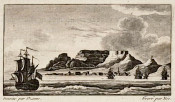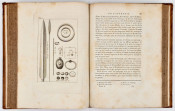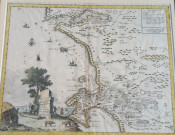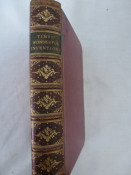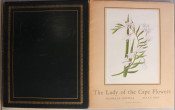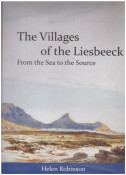Traduits, rédigés et augmentés de notes considérables sur la Religion, le Gouvernement, le Commerce, l'Industrie et les Langues de ces différentes contrées, particulièrement sur le Javan et le Malai; Par L. Langlès, Conservateur des Manuscrits orientaux de la Bibliothèque nationale, et Professeur de Persan, de Tatar-Mantchou, &c, à la même Bibliothèque; et revus, quant à la partie d'Histoire naturelle, par J. B. Lamarck, Professeur d'Entomologie et d'Helmentologie au Museum National d'Histoire naturelle.
Avec des Planches
First Quarto Edition: xliv-510, viii-544 pages, half title pages, frontispiece portrait of Thunberg in volume I, charming engraved vignette of Table Bay as the chapter head-piece of the Première Partie, engraved plate at page 258 of volume I, 27 engraved at the end of volume II, two gatherings printed on bluish paper, a little light foxing, full calf, red title labels on the spines with gilt decorations in panels, hinges splitting but holding firmly, marble endpapers, sprinkled edges, book plate on the front paste-down endpapers, a very good copy in a contemporary binding.
S2A3 Biographical Database of Southern African Science(https://www.s2a3.org.za/bio/Biograph_final.php?serial=2843)
‘Thunberg arrived in Table Bay on 16 April 1772 for a stay of three years. Upon arrival he met his Uppsala colleague, Anders Sparrman, who had arrived only a few days earlier. Initially he collected in the vicinity of Cape Town and was greatly interested in the Company's garden, where he met J.A. Auge. With Auge as his guide he set out on his first journey into the interior on 7 September 1772. They collected near Mamre for a week before travelling to Saldanha Bay. From there they turned east, followed the Berg River past the Piketberg, and crossed the mountains towards Roodezand (Tulbagh). After collecting in the vicinity for two weeks they continued south-eastwards and followed the Breede River to Swellendam. From there they travelled east via Mossel Bay and Knysna to Plettenberg Bay. In the Knysna forests the party was attacked by a buffalo which killed two of their horses. They continued north over the Outeniqua Mountains to the Langkloof, and then east as far as the Gamtoos River. On the return journey they kept north of the Outeniqua mountains and the Langeberg, crossed the latter at Plattekloof near present Heidelberg, and arrived back in Cape Town on 2 January 1773. That same month Thunberg met the French naturalist Pierre Sonnerat, with whom he collected plants and birds while they resided together at the farm of Mr M.A. Berg, secretary of the Council of Policy, near Constantia. Among their many excursions they climbed Table Mountain (which Thunberg did fifteen times during his three year stay). He was also sometimes accompanied by Captain (later Colonel) R.J. Gordon.
‘On 11 September 1773 Thunberg set out on his second journey, this time accompanied by Francis Masson. As on the first journey they first travelled to Salhdanha Bay, but from there went to collect in the Cold and Warm Bokkeveld. Following a similar route as on the first journey they travelled via Swellendam to Mossel Bay, then crossed the mountains via Attaquas Kloof (now Robinson Pass), and travelled east through the Langkloof and continued eastwards as far as the Sundays River. He arrived back in Cape Town on 28 January 1774. One of the persons he met in Cape Town this year was Lady Anne Monson.
‘Waiting for spring again Thunberg set out on his third and last journey, again in the company of Masson, on 29 September 1774. They climbed the Paardeberg, Riebeek Kasteel and Piketberg, followed the Verlorevlei to Elandsbaai, crossed the Olifants River and via the Gifberg (near present Van Rhynsdorp) reached the Bokkeveld Mountains. After ascending the plateau they explored botanically unknown territory in the Roggeveld. After descending to the lower country via Verlaten Kloof they went on to Verkeerde Vlei, via the Hex River Pass to Roodezand, and were back in Cape Town on 29 December 1774. He was the first private visitor to travel far into the interior, but his account of his travels was published after those of Masson and Anders Sparrman.’
Wikipedia(https://en.wikipedia.org/wiki/Carl_Peter_Thunberg)
‘Carl Peter Thunberg, also known as Karl Peter von Thunberg, Carl Pehr Thunberg, or Carl Per Thunberg (11 November 1743 – 8 August 1828), was a Swedish naturalist and an "apostle" of Carl Linnaeus. After studying under Linnaeus at Uppsala University, he spent seven years travelling in southern Italy and Asia, collecting and describing people and animals new to European science, and observing local cultures. He has been called "the father of South African botany", "pioneer of Occidental Medicine in Japan", and the "Japanese Linnaeus".’
‘Japan: In August 1775, he arrived at the Dutch factory of the V.O.C. at Dejima, a small artificial island (120 m by 75 m) in the Bay of Nagasaki connected to the city by a single small bridge. However, like the Dutch merchants, Thunberg was at first rarely allowed to leave the island. These restrictions had been imposed by the Japanese shogun Tokugawa Ieyasu in 1639 after the Portuguese, who had been the first Europeans to arrive in Japan in 1543, persisted in missionary activity. The only locals who were allowed regular contact with the Dutch were the interpreters of Nagasaki and the relevant authorities of the city.
‘Shortly after the Schoonzicht's arrival on Deshima, Thunberg was appointed head surgeon of the trading post. To still be able to collect specimens of Japanese plants and animals as well as to gather information on the population, Thunberg began to construct networks with the interpreters by sending them small notes containing medical knowledge and receiving botanical knowledge or rare Japanese coins in return. Quickly, the news spread that a well-educated Dutch physician was in town who seemed to be able to help the local doctors cure syphilis, known in Japan as the "Dutch disease". As a result, the appropriate authorities granted him more visits to the city and finally even allowed him one-day trips into the vicinity of Nagasaki, where Thunberg had the chance to collect specimens by himself.
‘During his visits in town, Thunberg began to recruit students, mainly the Nagasaki interpreters and local physicians. He taught them new medical treatments, such as using mercury to treat syphilis, and the production of new medicines. During this process, he also instructed his pupils in the Dutch language and ‘European manners, furthering the growing interest into Dutch and European culture by the Japanese, known as rangaku.[10] Thunberg had brought some seeds of European vegetables with him and showed the Japanese some botanical practices, expanding Japanese horticultural practices.
‘Thunberg also profited from his teachings himself. As a former medical student he was mainly interested in medical knowledge, and the Japanese showed him the practice of acupuncture. The exchange of ideas between Thunberg and the local physicians led to the development of a new acupuncture point called shakutaku. The discovery of shakutaku was a result of Thunberg's anatomic knowledge and the Japanese traditional medicine of neuronic moxibustion. Thunberg brought back knowledge on Japan's religion and societal structure, boosting interest into Japan, an early cultural form of Japonism.
In both countries, Thunberg's knowledge exchange led to a cultural opening-up, which also manifested itself in the spread of universities and boarding schools which taught knowledge of the other culture. For this reason, Thunberg has been called "the most important eye witness of Tokugawa Japan in the eighteenth century".
‘Due to his scientific reputation, Thunberg was given the opportunity in 1776 to accompany the Dutch ambassador M. Feith to the shogun's court in Edo, today's Tokyo. During that journey, he collected many specimens of plants and animals and talked to locals along the way. It is during this time that Thunberg started writing two of his scientific works, the Flora Japonica (1784) and the Fauna Japonica (1833). The latter was completed by the German traveller Philipp Franz von Siebold, who visited Japan between 1823 and 1829 and based the Fauna Japonica on Thunberg's notes which he carried with him all the time in Japan.
‘On his way to Edo, Thunberg also obtained many Japanese coins, which he described in detail in the fourth volume of his travelogue, Travels in Europe, Africa and Asia, performed between the Years 1770 and 1779. The coins provided new insights for European scholars into the culture, religion and history of Japan, as their possession and export by foreigners had been strictly forbidden by the shogun. This prohibition had been imposed to prevent the Empire of China and other rivals of the shogunate from copying the money and flooding the Japanese markets with forged coins.
‘In November 1776, after Thunberg had returned from the shogun's court, he left for Java, now part of Indonesia. From there, he travelled to Ceylon (now Sri Lanka) in July 1777. Here again, his major interest lay in collecting plants and other specimens.
‘In February 1778, Thunberg left Ceylon to return to Europe.'
- Overall Condition: A very good copy
- Size: 4to (260 x 195 mm)

.jpg)
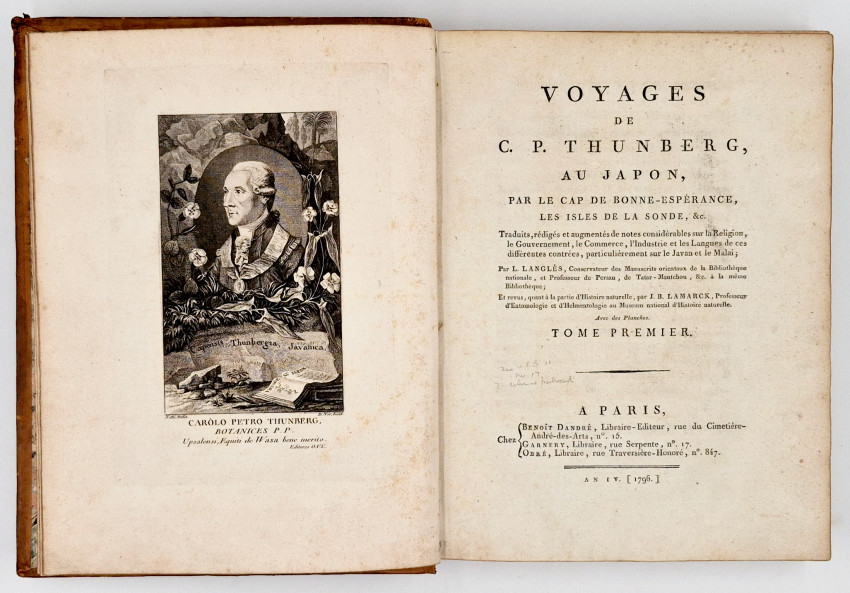
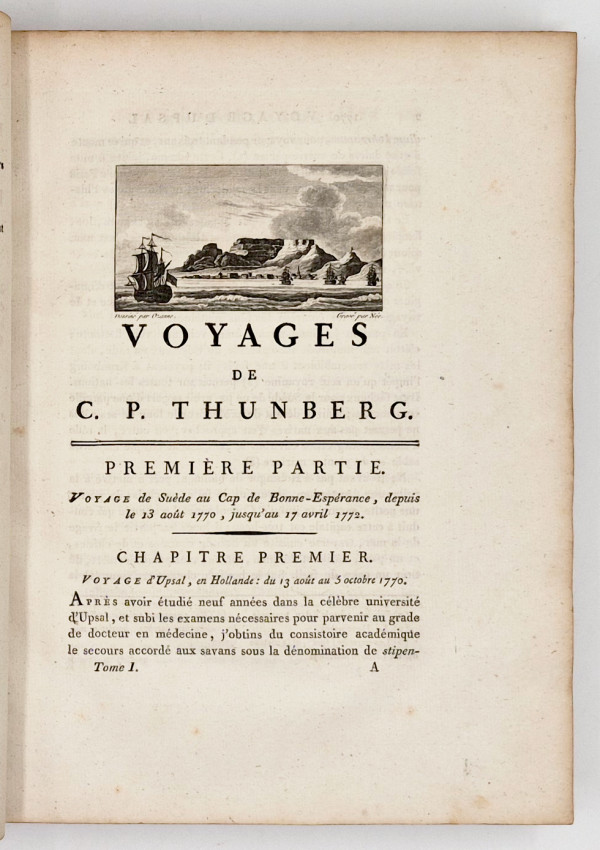


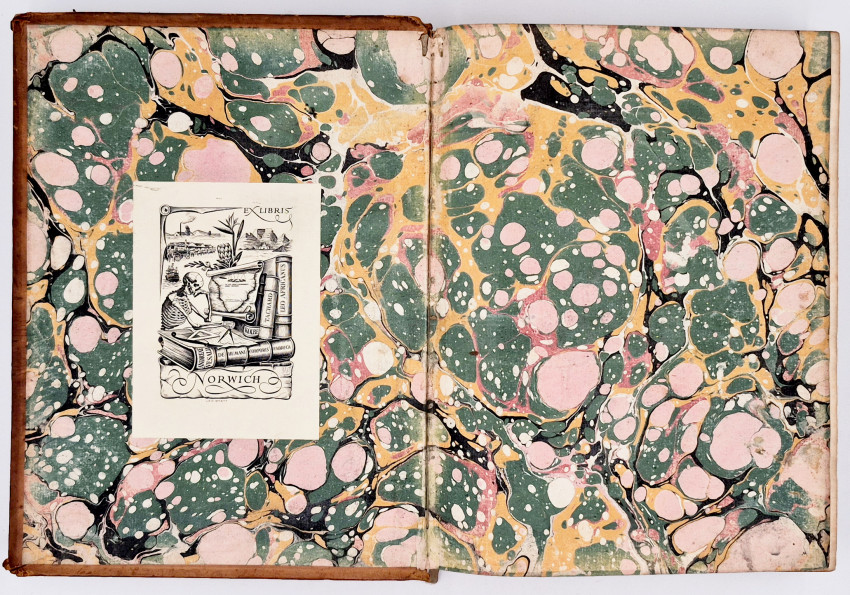

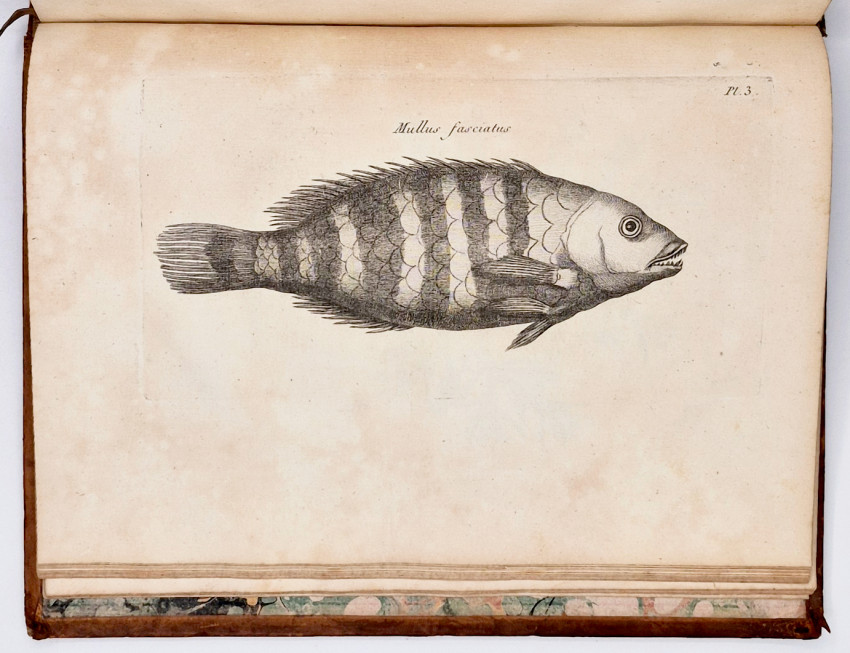
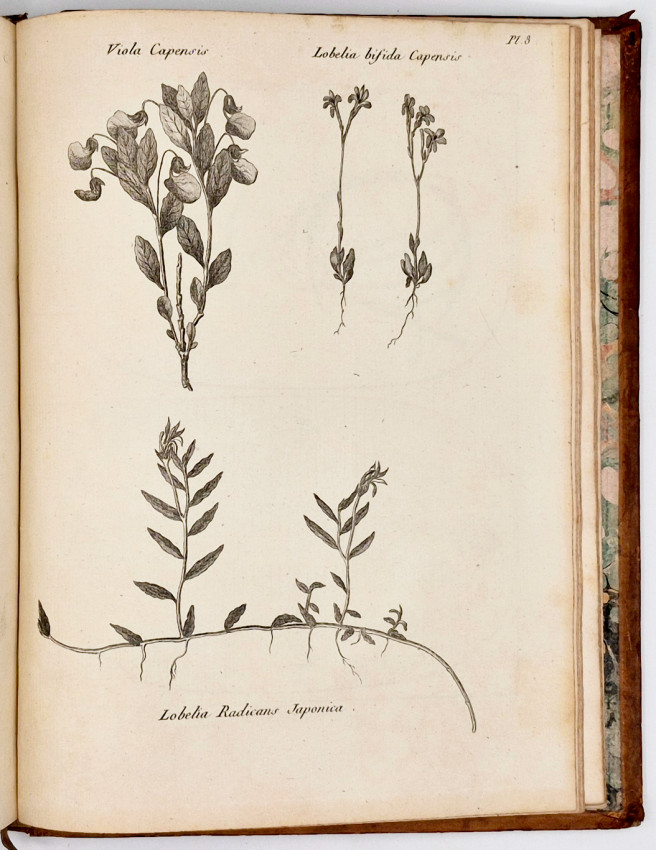
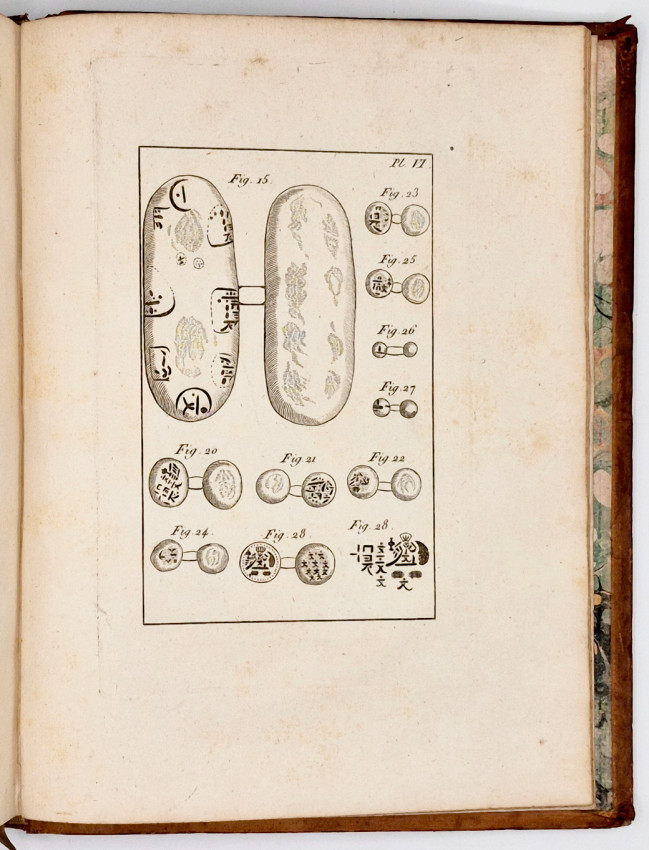
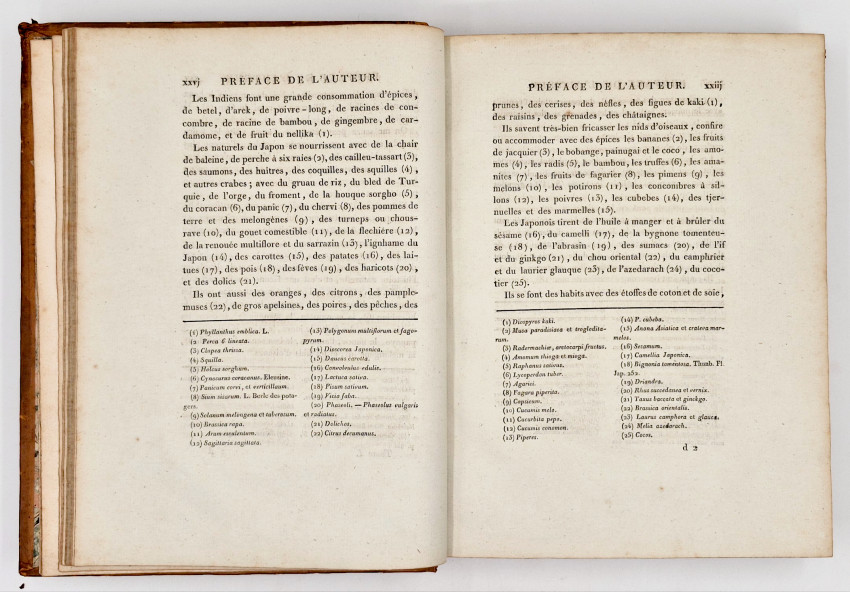
.jpg)


